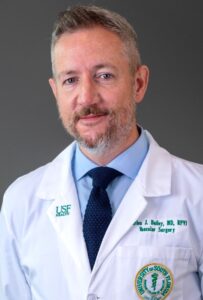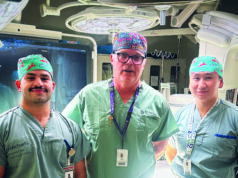
This advertorial is sponsored by Tampa General Hospital.
Operating in Tampa, Florida, Charles J. Bailey, MD, and his partners in the Division of Vascular Surgery at the University of South Florida see their fair share of preventable amputations. In a region of the Sunshine state with an ethnically and socioeconomically diverse population, he treats patients from many of its most disparately hit communities, among a demographic whose healthcare outcomes and rates of major lower-extremity amputation often diverge from the national mean.
This is the challenge embraced by the team he leads in the Limb Preservation-Peripheral Arterial Disease (PAD) Program within the Tampa General Hospital (TGH) Heart & Vascular Institute (HVI)-Vascular Center of Excellence, to provide not only the highest quality evidence-based vascular care but to also create a team and program focused on addressing the disparities in healthcare delivery and outcomes in his own community.
That’s why a new satellite clinic in the Tampa area—the first of its kind in the region—has Bailey excited at the potential for his multidisciplinary team to make a true impact on limb salvage and rates of major lower-extremity amputations. The need for cross-specialty care is key, he emphasizes.
“The care of patients with advanced peripheral arterial disease (PAD), chronic limb-threatening ischemia (CLTI) in the form of rest pain or non-healing wounds really requires an integrated, collaborative, evidence-based approach to give a patient the best chance of limb salvage and an amputation-free survival,” says Bailey, director of the HVI-Vascular Center of Excellence and medical director of the Limb Preservation-PAD Program.

“Our team of surgeons and specialists embrace the newest research and technology and work as partners to provide a treatment plan as unique as each patient. The LPP clinic will represent the first off-campus satellite clinic for the Heart & Vascular Institute and offers a novel level of care to our medical community. Many non-traumatic amputations are preventable, and programs like ours have proven to reduce amputation rates and improve healthcare-related quality of life for PAD patients.
“Caring for a patient at risk for amputation is not simply about improving blood flow, caring for a wound, or ensuring the right antibiotics or medical risk factor management is being provided. Each piece of the puzzle is unique, though intimately connected to those around it. Forming a multidisciplinary clinic gives us the ability to treat our patients uniquely and with enhanced efficiency.”
Bailey and his colleagues at the TGH HVI-Vascular Center of Excellence figure among the leading experts in the treatment of PAD its the end-stage form of the disease, CLTI. The team, explains Bailey, is acutely aware of the need for such a satellite clinic in the Tampa area in order to tackle some of the most challenging outcomes associated with CLTI. He points to peer-reviewed research showing that multidisciplinary care improves amputation-free survival1 and reduces rates of major limb amputation.2
“A risk factor for PAD and a common catalyst for amputation in our community is diabetes,” notes Bailey. “According to the Centers for Disease Control and Prevention (CDC), 154,000 lower-extremity amputations are done each year in the U.S. for adults who are diabetic. Within this number is a glaring example of the disparities in our healthcare system. As compared to non-Hispanic White Americans, Black Americans are up to four-times—and Latinx are over 50%—more likely to suffer a major lower-extremity amputation.
“Preventing an amputation is not solely a vascular, podiatry, or wound care problem, it is a public health crisis. Early disease detection and management, medical education to both patient and practitioners, and improving access to high-quality vascular care is essential. The very roots and foundation of Tampa is intertwined with the Latinx community, so creating an off-campus satellite clinic was mission-critical.
“We are taking our multidisciplinary program and the goals of limb salvage—and reducing healthcare disparities—directly into the community that needs us. Tampa General Hospital sits on an island, and ‘moving off the island,’ is proof that coordinated multi-specialty care can be provided outside of the traditional academic medical center confines, and we see this as a necessary step in our commitment towards being present and active in addressing the public health needs of all. The Limb Preservation-PAD Program is truly the first and only of its kind in the Tampa Bay area to provide such a multidisciplinary, integrated, evidence-based approach to the management and care of patients with complex PAD,” adds Bailey.
References
- Jayer Chung, MD, J. Gregory Modrall, MD, Chul Ahn, PhD, Lawrence A. Lavery, DPM, and R. James Valentine, MD. Multidisciplinary care improves amputation-free survival in patients with chronic critical limb ischemia. J Vasc Surg 2015;61:162-9.
- Alyssa M. Flores, BS, Matthew W. Mell, MD, MS, Ronald L. Dalman, MD, and Venita Chandra, MD. Benefit of multidisciplinary wound care center on the volume and outcomes of a vascular surgery practice. J Vasc Surg 2019; 70:1612-9.












